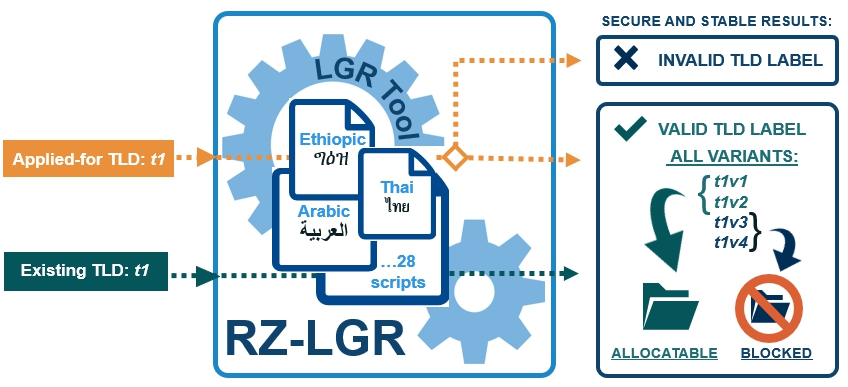Root Zone Label Generation Rules
Root Zone Label Generation Rules (RZ-LGR) provide a conservative mechanism to determine valid IDN TLDs and their variant labels, for stable and secure operation of the DNS Root Zone. To learn more about why IDNs are important to the community and a multilingual Internet, view our script community leader quote page here.
Using the RZ-LGR
With the availability of the RZ-LGR and its fundamental role envisaged for defining the variant labels of top-level domains (TLDs), the ICANN Board asked the ICANN community to recommend how to technically apply the RZ-LGR in a harmonized way to generic and country code top-level domains. The Recommendations for the Technical Utilization of the Root Zone Label Generation Rules were published by the RZ-LGR Study Group, and submitted to the ICANN Board. Through its resolution, the ICANN Board has requested the ccNSO and GNSO to take these recommendations into account while developing their respective policies to define and manage the IDN variant TLDs for current TLDs as well as for the future TLD applications.
Root Zone Label Generation Rules Version 5
Root Zone Label Generation Rules Version 5 (RZ-LGR-5) is now available, covering the following twenty-six scripts: Arabic, Armenian, Bangla, Chinese (Han), Cyrillic, Devanagari, Ethiopic, Georgian, Greek, Gujarati, Gurmukhi, Hebrew, Japanese (Hiragana, Katakana, and Kanji [Han]), Kannada, Khmer, Korean (Hangul and Hanja [Han]), Lao, Latin, Malayalam, Myanmar, Oriya, Sinhala, Tamil, Telugu, and Thai.
- RZ-LGR-5 Overview and Summary
- RZ-LGR-5 Repertoire Tables, non-CJK
- RZ-LGR-5 Repertoire Tables, Han
- RZ-LGR-5 Repertoire Tables, Hangul
- RZ-LGR-5-Merged-LGR-Common (XML, HTML)
- RZ-LGR-5-Element-LGR-ArabicScript (XML, HTML)
- RZ-LGR-5-Element-LGR-ArmenianScript (XML, HTML)
- RZ-LGR-5-Element-LGR-BanglaScript (XML, HTML)
- RZ-LGR-5-Element-LGR-ChineseScript (XML, HTML)
- RZ-LGR-5-Element-LGR-CyrillicScript (XML, HTML)
- RZ-LGR-5-Element-LGR-DevanagariScript (XML, HTML)
- RZ-LGR-5-Element-LGR-EthiopicScript (XML, HTML)
- RZ-LGR-5-Element-LGR-GeorgianScript (XML, HTML)
- RZ-LGR-5-Element-LGR-GreekScript (XML, HTML)
- RZ-LGR-5-Element-LGR-GujaratiScript (XML, HTML)
- RZ-LGR-5-Element-LGR-GurmukhiScript (XML, HTML)
- RZ-LGR-5-Element-LGR-HebrewScript (XML, HTML)
- RZ-LGR-5-Element-LGR-JapaneseScript (XML, HTML)
- RZ-LGR-5-Element-LGR-KannadaScript (XML, HTML)
- RZ-LGR-5-Element-LGR-KhmerScript (XML, HTML)
- RZ-LGR-5-Element-LGR-KoreanScript (XML, HTML)
- RZ-LGR-5-Element-LGR-LaoScript (XML, HTML)
- RZ-LGR-5-Element-LGR-LatinScript (XML, HTML)
- RZ-LGR-5-Element-LGR-MalayalamScript (XML, HTML)
- RZ-LGR-5-Element-LGR-MyanmarScript (XML, HTML)
- RZ-LGR-5-Element-LGR-OriyaScript (XML, HTML)
- RZ-LGR-5-Element-LGR-SinhalaScript (XML, HTML)
- RZ-LGR-5-Element-LGR-TamilScript (XML, HTML)
- RZ-LGR-5-Element-LGR-TeluguScript (XML, HTML)
- RZ-LGR-5-Element-LGR-ThaiScript (XML, HTML)
These files can be collectively downloaded with this package.
Successful development of Label Generation Rules depends on having community based Generation Panels for each script or writing system that will be used in the Root Zone. The Generation Panels start with a broad set of code points for the relevant script(s), known as the Maximal Starting Repertoire, and propose relevant Label Generation Rules. These proposals are reviewed by the community through public comment and then by the Integration Panel for approval and integration into the LGR for the Root Zone. The details are defined in Procedure to Develop and Maintain the Label Generation Rules for the Root Zone in Respect of IDNA Labels [PDF, 1.39 MB].
For related information, visit the following links:
- Proposals for Root Zone LGR
- Status of Generation Panels
- Quotes from Generation Panel leaders
- Maximal Starting Repertoire
- Guidelines for Developing Script-Specific LGRs
Speak up for your language. Please email at IDNProgram@icann.org to contribute to the relevant Generation Panel.
Earlier Versions of Root Zone Label Generation Rules
Root Zone Label Generation Rules Version 4 (RZ-LGR-4) covered Arabic, Bangla, Chinese, Devanagari, Ethiopic, Georgian, Gujarati, Gurmukhi, Hebrew, Kannada, Khmer, Lao, Malayalam, Oriya, Sinhala, Tamil, Telugu, and Thai scripts. The RZ-LGR-4 package includes the following documents:
- RZ-LGR-4 Overview and Summary
- RZ-LGR-4 Repertoire Tables, non-CJK
- RZ-LGR-4 Repertoire Tables, Han
- RZ-LGR-4-Merged-LGR-Common (XML, HTML)
- RZ-LGR-4-Element-LGR-ArabicScript (XML, HTML)
- RZ-LGR-4-Element-LGR-BanglaScript (XML, HTML)
- RZ-LGR-4-Element-LGR-ChineseScript (XML, HTML)
- RZ-LGR-4-Element-LGR-DevanagariScript (XML, HTML)
- RZ-LGR-4-Element-LGR-EthiopicScript (XML, HTML)
- RZ-LGR-4-Element-LGR-GeorgianScript (XML, HTML)
- RZ-LGR-4-Element-LGR-GujaratiScript (XML, HTML)
- RZ-LGR-4-Element-LGR-GurmukhiScript (XML, HTML)
- RZ-LGR-4-Element-LGR-HebrewScript (XML, HTML)
- RZ-LGR-4-Element-LGR-KannadaScript (XML, HTML)
- RZ-LGR-4-Element-LGR-KhmerScript (XML, HTML)
- RZ-LGR-4-Element-LGR-LaoScript (XML, HTML)
- RZ-LGR-4-Element-LGR-MalayalamScript (XML, HTML)
- RZ-LGR-4-Element-LGR-OriyaScript (XML, HTML)
- RZ-LGR-4-Element-LGR-SinhalaScript (XML, HTML)
- RZ-LGR-4-Element-LGR-TamilScript (XML, HTML)
- RZ-LGR-4-Element-LGR-TeluguScript (XML, HTML)
- RZ-LGR-4-Element-LGR-ThaiScript (XML, HTML)
These files can be collectively downloaded with this package.
Root Zone Label Generation Rules Version 3 (RZ-LGR-3) covered Arabic, Devanagari, Ethiopic, Georgian, Gujarati, Gurmukhi, Hebrew, Kannada, Khmer, Lao, Malayalam, Oriya, Sinhala, Tamil, Telugu, and Thai scripts. The RZ-LGR-3 package included the following documents:
- RZ-LGR-3 Overview and Summary
- RZ-LGR-3 Repertoire Tables, non-CJK
- RZ-LGR-3-Merged-LGR-Common (XML, HTML)
- RZ-LGR-3-Element-LGR-ArabicScript (XML, HTML)
- RZ-LGR-3-Element-LGR-DevanagariScript (XML, HTML)
- RZ-LGR-3-Element-LGR-EthiopicScript (XML, HTML)
- RZ-LGR-3-Element-LGR-GeorgianScript (XML, HTML)
- RZ-LGR-3-Element-LGR-GujaratiScript (XML, HTML)
- RZ-LGR-3-Element-LGR-GurmukhiScript (XML, HTML)
- RZ-LGR-3-Element-LGR-HebrewScript (XML, HTML)
- RZ-LGR-3-Element-LGR-KannadaScript (XML, HTML)
- RZ-LGR-3-Element-LGR-KhmerScript (XML, HTML)
- RZ-LGR-3-Element-LGR-LaoScript (XML, HTML)
- RZ-LGR-3-Element-LGR-MalayalamScript (XML, HTML)
- RZ-LGR-3-Element-LGR-OriyaScript (XML, HTML)
- RZ-LGR-3-Element-LGR-SinhalaScript (XML, HTML)
- RZ-LGR-3-Element-LGR-TamilScript (XML, HTML)
- RZ-LGR-3-Element-LGR-TeluguScript (XML, HTML)
- RZ-LGR-3-Element-LGR-ThaiScript (XML, HTML)
These files can be collectively downloaded with this package.
Root Zone Label Generation Rules Version 2 (RZ-LGR-2) covered Arabic, Ethiopic, Georgian, Khmer, Lao and Thai scripts. The RZ-LGR-2 package included the following documents:
- RZ-LGR-2 Overview and Summary
- RZ-LGR-2 Repertoire Tables, non-CJK
- RZ-LGR-2-Merged-LGR-Common (XML, HTML)
- RZ-LGR-2-Element-LGR-ArabicScript (XML, HTML)
- RZ-LGR-2-Element-LGR-EthiopicScript (XML, HTML)
- RZ-LGR-2-Element-LGR-GeorgianScript (XML, HTML)
- RZ-LGR-2-Element-LGR-KhmerScript (XML, HTML)
- RZ-LGR-2-Element-LGR-LaoScript (XML, HTML)
- RZ-LGR-2-Element-LGR-ThaiScript (XML, HTML)
These files can be collectively downloaded with this package.
Root Zone Label Generation Rules Version 1 (RZ-LGR-1) covered the Arabic script. The RZ-LGR-1 package included the following documents:
- RZ-LGR-1 Overview and Summary
- RZ-LGR-1 Code Table
- RZ-LGR-1-Merged-LGR-Common (XML, HTML)
- RZ-LGR-1-Element-LGR-ArabicScript (XML, HTML)

